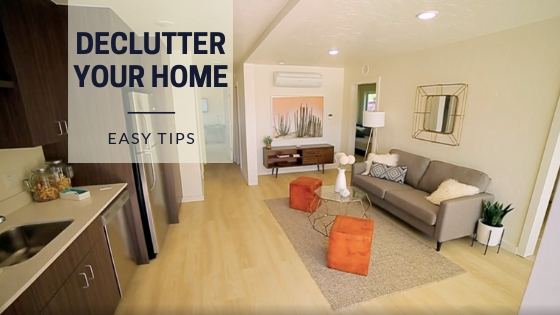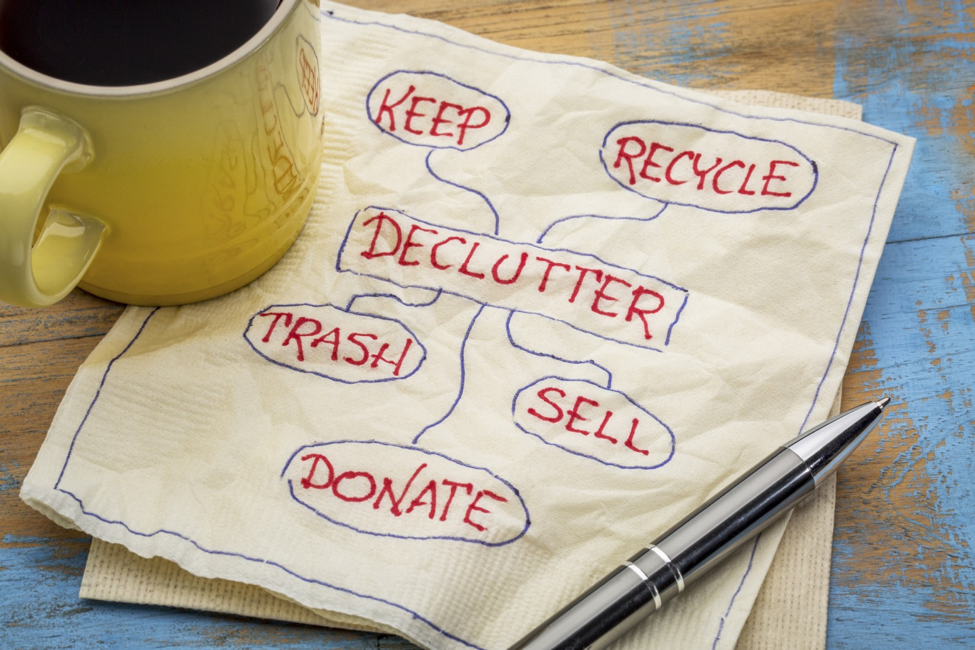
Decluttering Your Space: How to Create a Clutter-Free Home
With our hectic schedules, we all let our home go astray from time to time.
Create a clutter-free home with these quick and easy decluttering tips!
Hands up if this is the year you've promised yourself you're finally getting organized?
If your hand is up, you're not alone.
The discussion around the dangers of living in a cluttered home is growing. Marie Kondo has helped educate people about how to declutter their space. Along with this, more and more people have realized that they no longer need a home full of things.

Benefits of a Clutter-Free Home
Research shows that living a clutter-free life really can help promote mental, physical, and even financial benefits.
A cluttered home is overwhelming to live in. It's easy to feel as though your life is spinning out of control when you're surrounded by stuff. The stress of frantically searching for your keys or wallet when trying to leave home is something most people can relate to.
As you being the process of house organization, a sense of hope will begin to arise. Hope that your life will simplify, become less rushed and stressful than it was amidst the debris.
The ability to regain a feeling of control over your life through simply decluttering your home is priceless. Another one of the most significant benefits of decluttering is creating more time to spend on what’s meaningful to you.
Simply having fewer things to clean and pack away means that your time is opened up to spend with your friends and family. Buying less stuff always means spending less money, having less debt, and overall, less time spent worrying about all the stuff.
While many people realize that their lives will be better off with less, they're worried about where to begin.
How to Declutter Your Home
We've mentioned that many feel defeated when they think about starting to declutter their home. The good news is that the journey to less doesn't have to be as painful as some make it out to be.
These days, there are a bunch of fun, creative ways to get started with tidying up. We've created a declutter home checklist. Keep reading to find out simple steps to take toward a less cluttered life.
Set Definable Goals
To make a start in this process of minimizing your stuff, you'll first need to set clear, achievable goals.
Many people put off their decluttering because they say they can't find the time. If you see it as a massive task, you'll most likely continue to avoid it at all costs.
The reality is that you're never going to find a full weekend or even a whole day to get it done. Due to this, it's essential to set definable goals that are smaller and more manageable.
Perhaps it makes sense to tackle one closet at a time or even a whole room at a time. It's helpful to allot a certain amount of hours, after which you stop and come back the next day if necessary.
The most important thing isn't what goals you set, but rather, the focus should be on setting goals that work for you. Everyone is different with a different sized space. Divide your work into sections and move through them, instead of trying to do it all in one go.
Throw it Out
When you start going through your things, you'll be surprised how much of it is useless to you. While some items may be actual garbage, there's a chance that someone else could benefit from the belongings you no longer use. In this case, you can donate to a women's shelter or animal rescue organization.
For the garbage, it's easy to take a large trash bag around the work area you're focusing on. You'll quickly notice that the bag will fill up in no time at all. If you need help with waste removal, contact companies like Dog Gone Junk.
Remember that if you haven't used it in a while, there's no point in keeping it. Ripped clothing and broken toys or electronics are some examples of items that you simply need to throw in the trash or recycling.
The chances are, if you haven't got around to fixing them by now, you never will.
Create Stations
During your goal for the day, it may be useful to set up different stations in separate containers.
This process is the part where you can truly see how much you need to keep. You can use labeled boxes or even just designated sections of a room.
It usually works to set up four stations. One for donation, garbage, relocation, and keep. It makes everything much more manageable when you can see it laid out in individual stations.
As you go through your space, you need to be brutal. Everything must go into one of these sections. In the end, you can reassess and, hopefully, throw out more items than you initially intended!
Ask Yourself Questions
Creating a list of questions will help you decide which section to place each item in.
For example, if you find that everything is landing up in the keep pile, what does this mean? Perhaps you're pretty organized, to begin with? The most likely answer may disappoint you.
You're simply not being brutal enough.
To help you along with this, sometimes harsh, process, we've laid down a helpful list of questions to ask yourself:
- Is it broken?
- Can you use it?
- Can anyone else use it?
- Do you feel any negative feeling about it?
- Do you love it?
You need to be strict. If it's stained, broken or unusable, you must put it in the garbage or recycle pile. On the other hand, if something is useful, decide whether it’s useful to you or if it would be better to donate it. Then put it straight in the appropriate pile.
Follow the Rules
Some items require more than just the questions mentioned above to sort through them.
In these cases, it's helpful to have specific rules to stick to. For example, a piece of clothing may be in good condition, but it's too small for you. Setting a rule here regarding clothing size can make a big difference.
The rule could be as follows: if the item is more than one or two sizes too small, donate it. Someone else could benefit from a piece of clothing you'll realistically never wear again.
Other examples could be that books you've already read should be donated and magazines that are older than a specific number of years to go to recycling.
Of course, you have to figure out what feels right for you. The main thing is that you stick to your rules.
Expiration Dates
Lastly, for confusing items, you'll need to set some expiration dates.
These items are the ones that may belong to another family member. Or you know they once were important, but you're simply unsure if you still need them.
These are items like cables or cords, as you know they may be useful. If, for instance, you run into some random cables that you think are for the Christmas decorations, you can put a year expiry date on them. If you haven't figured out their use within the year, you can get rid of them.
Designate a specific spot for these things and label them with their expiration date. It's easy - if you haven't needed it within a year, you'll probably never need it again.
The Next Steps
People become burdened with too many things for a few reasons. Inheriting items from a loved one is a common cause for clutter. People feel a sense of attachment when they inherit from loved ones.
It can be challenging to let these items go due to their sentimental value. Along with this, transitions into a new job, house, or the arrival of a baby can all take time and energy away from home management. It's completely understandable.
In these cases, people become so focused on their new life transition that they begin to neglect their living space. Things pile up quickly, and the next thing they know they're surrounded by stuff.
Though we can agree, it's clear that the benefits of a clutter-free home far outweigh the effort it takes to get there.
So, what are the next steps?
You must be proactive and start somewhere. Visit our blog if you or someone you know needs more encouragement to get started.
